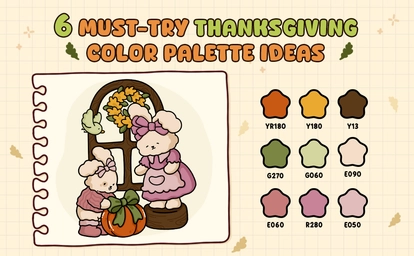

Both beginners and experts can enjoy books.

Prevents bleed-through and protects every design.

Every design is created by skilled human artists.

Trusted and loved by coloring fans worldwide.
You have questions? We're here to help.

Fuzzy Buddies is an enjoyable coloring book. I love seeing the pages come to life after coloring. Great buy.
Amazon customer
I bought this for my fiance and she loves it! It's adorable and she says it's fun to draw. I love it! It also came in a day early!
Amazon customer
Such a cute and fun book to color. I can't put it down! I love how easy they are.
Amazon customer
This book is a gem: the drawings are very well done, clear and realistic. The scenes are very varied. Well suited for coloring with alcohol markers in this case. I recommend +++
Amazon customer
This colouring book is so cute! The line art is black and thick which is ideal for colouring with alcohol markers. The designs are all super cute! There are pages in this book that I haven’t seen in other books. I recommend 👍
Amazon customer
I caved and joined in the cute Halloweeny colouring bandwagon! I'm happy with this book, it's so cute! I like the size, it's not too big so it's easier to complete. Very cute designs. The paper is thinner than I'd like but it's okay if you put card behind the page you're working on.
Amazon customer
What a dream to have a pleasant time at any age coloring these very funny drawings. Really I recommend it feels good and relaxing as much as possible doing mandalas for those who like it.
Amazon customer
I bought it for my grandma so she wouldn't be bored this winter, she loves everything related to the fairy world, goblins etc... The designs are very cute and varied! The leaves look fine so in my opinion it is not made for people who have alcohol markers.
Amazon customer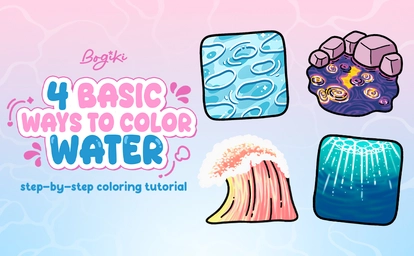
Learning how to color water is more than just filling a page with blue. So, how to color water effectively? Using 4 Ways to Color Water Step-by-Step Tutorial with alcohol markers will help you achieve realistic effects, depth, and reflections. This guide introduces practical, step-by-step techniques for coloring basics, including under the sea coloring pages, lake water coloring, and ocean waves coloring pages, helping you elevate your artwork.
Understanding how to color water begins with water color basics. The Basic Water method is perfect for smooth, natural water surfaces in ponds, streams, or still water. By layering colors and controlling shadows, you can create realistic depth while practicing foundational water coloring skills.
Step 1: Apply the Base Coat: Use (BG4) and (B250) to lay a soft gradient across the water, leaving lighter areas for highlights. This base creates a natural foundation for shadows and reflections.
Step 2: Add Initial Shadows: Apply (PB9) to darker areas such as under floating objects or along shallow ripples. Keep strokes gentle to maintain smooth transitions.
Step 3: Deepen Shadows: Use (PB8) for finer shadow details to enhance depth and movement within the water.
Step 4: Sketch Gentle Ripples: Draw subtle curved lines to mimic water movement and create natural flow.
Step 5: Highlight Sparkles: Finish with a white gel pen to add reflections and shimmering points, enhancing realism.
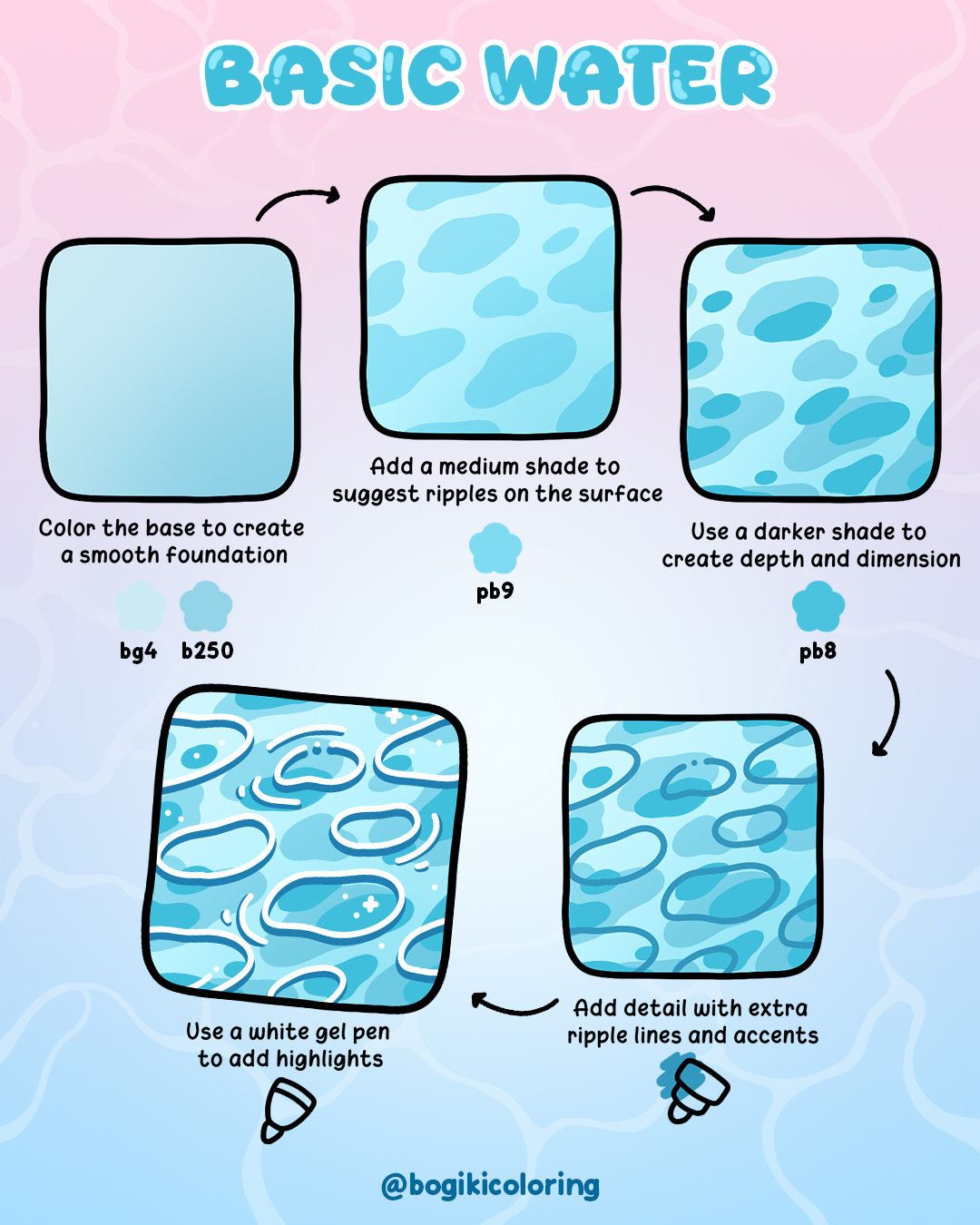
For under the sea coloring pages, learning how to color water helps you practice blending, layering, and shading techniques. The Under the Sea method emphasizes underwater depth and subtle color transitions, creating realistic water paint effects.
Step 1: Blend the Gradient Background: Use (G420) and (G4) to create smooth color transitions, from light near the surface to darker areas below.
Step 2: Add Hidden Waves: Draw gentle undulations under the surface with (B090) and (BG7) to suggest movement and texture.
Step 3: Enhance Shadows: Apply (PB6) in the darker areas to increase depth and layered effects.
Step 4: Highlight Surface Patterns: Sketch soft, scattered lines with (G326) to represent subtle water movement above.
Step 5: Add Sparkling Light: Use a white gel pen to simulate sunlight filtering through the water, adding shimmer and depth.
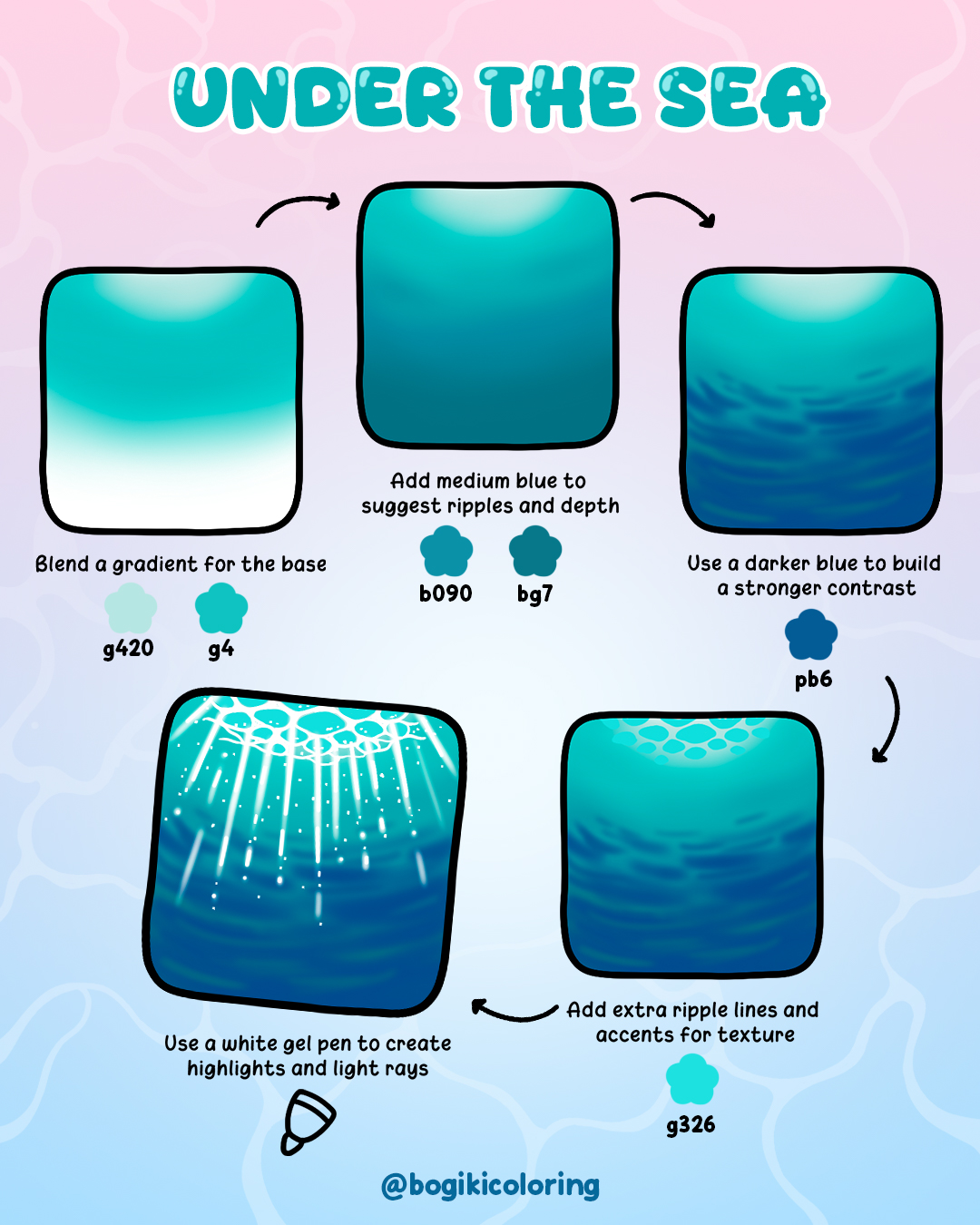
Creating calm lake scenes requires understanding how to color water for realistic lake water color illustrations. The Reflective Lake method focuses on mirror-like surfaces, layering, and the addition of tints to capture natural reflections.
Step 1: Apply Light Base: Use (Y6) for the water surface and (RV200) and (TU180) for the surrounding shoreline and rocks.
Step 2: Introduce Subtle Purple Tones: Apply (RP6) to shaded areas for soft reflective effects on the water.
Step 3: Deepen Edges and Shadows: Use (V320) and (FY050) along edges and near the shore to enhance depth perception.
Step 4: Sketch Gentle Ripples: Draw subtle wave lines with (YR2) to show movement and changes in reflections.
Step 5: Add Highlights: Use a white gel pen for sparkling points to mimic natural light reflections.

For ocean waves coloring pages, learning how to color ocean waves involves blending gradients, adding detailed wave lines, and highlighting foam. The Ocean Waves technique helps you practice color waves and create energetic, realistic seas.
Step 1: Create Gradient Base: Blend (Y1) at wave tops, (Y3) in the midsection, and (Y130) at the base. Smooth horizontal strokes ensure a natural gradient.
Step 2: Add Fine Wave Details: Use (R050) to define wave crests, focusing on curling areas. Vary line thickness for natural texture.
Step 3: Enhance Wave Peaks: Apply (R070) to the top of selected waves to create dimension and contrast.
Step 4: Blend and Adjust: Layer (Y3), (Y130), and (R1) lightly to unify colors and smooth transitions, balancing shadows and highlights.
Step 5: Highlight Foam and Splashes: Use a white acrylic pen to add foam and water splashes along wave crests, applying small, irregular strokes and dots for shimmer.
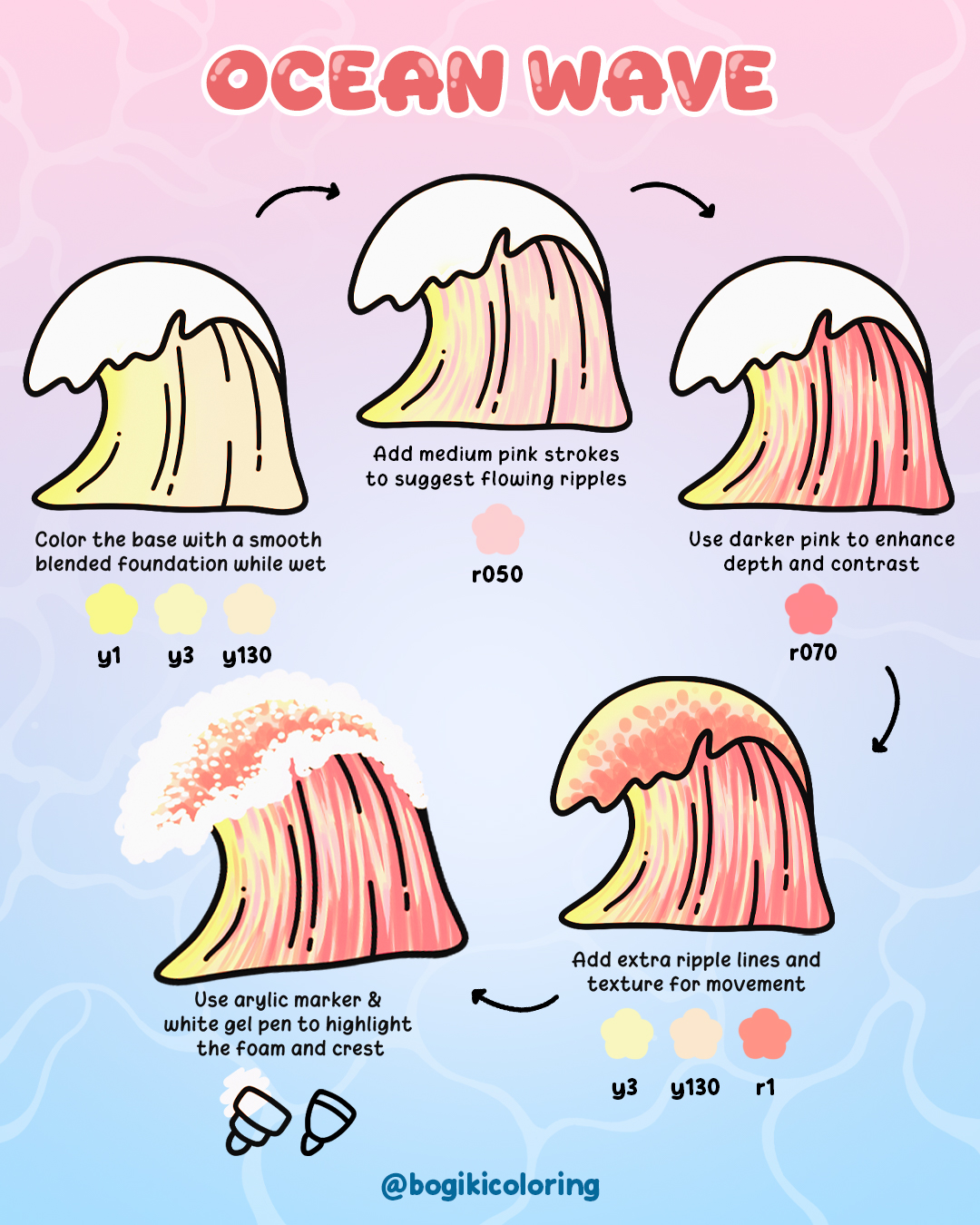
Layer Gradually: Build colors in thin layers to create depth and smooth transitions.
Control Water Flow: Adjust water and pigment for soft gradients or sharper edges.
Mix Shadows Thoughtfully: Use darker tones selectively for depth without overpowering.
Use White for Highlights: Gel pens or acrylic markers create shimmer and reflections.
Experiment with Texture: Add small dots, wave lines, or splashes to enhance realism.
How to Color Water: 4 Ways Watercolor Tutorials Step-by-Step is just a small part of How To Color Cozy Things. With this guide, you’ll not only learn how to color water step by step but also have the opportunity to explore many other step-by-step tutorials for commonly featured images in coloring pages, such as flowers, leaves, trees, night skies, lakes, oceans, and many other scenes.
You can practice various watercolor techniques, layer colors, add shadows and highlights, and create vibrant effects of water, light, and color. The illustrations are designed so that you can both relax and develop your creative skills, from basic to advanced levels, expanding your ability to color a wide variety of images.
👉 Explore Bogiki coloring guide and start your step-by-step tutorials journey today.

Discover the joys of coloring books for beginners! In this guide, you’ll learn the benefits of coloring, follow 3 simple steps to choose the right coloring book, and explore 3 Bogiki books ideal for starting your creative journey. y. First, let’s explore how coloring can benefit you.
Coloring helps you find your flow again. As your hand moves and colors blend, your focus sharpens, your thoughts align, and calm concentration takes shape.
Some days, you just need something gentle. Coloring gives you that quiet pause, a few soft minutes to breathe, unwind, and feel the world ease around you.
One of the loveliest things about coloring is that it doesn’t ask for perfection. You can go outside the lines, change your colors halfway, or leave a page unfinished, and it still feels beautiful.
With coloring books, the journey matters more than the result.
Every page in your coloring book is a little reflection of who you are. You might fill it with warm oranges on a cozy day, or deep blues when you want some quiet; either way, it’s all you.
You don’t have to explain anything, just color how you feel, and let your emotions turn into art.
Choosing your first coloring book is about more than just picking pretty pages; it’s about finding a book that truly matches your needs, style, and creative inspiration. The right book will help you stay engaged and enjoy coloring consistently, rather than giving up halfway.
Here are 3 simple steps to help beginners choose a suitable coloring book.
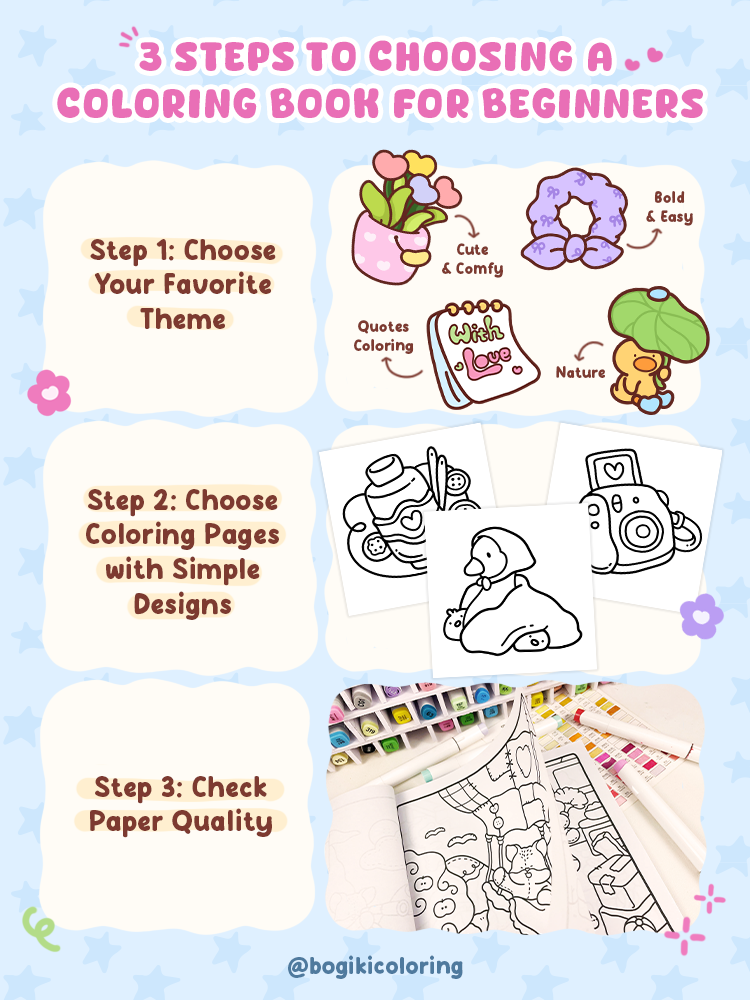
Start by asking: What do I want to feel while coloring?
Need to unwind fast? → Try a Bold & Easy Coloring Book, with big, simple shapes that help you relax and enjoy quickly.
Feeling soft and cozy? → Choose a Cute & Comfy Coloring Book, filled with sweet girls, cuddly animals, and gentle designs that melt your heart.
Want to reconnect with nature? → Pick a Nature Coloring Book, featuring flowers, leaves, and mushrooms
Once you’ve chosen a theme that excites you, the next step is to select coloring pages with a suitable design. As a beginner, you’ll enjoy your experience much more with pages that have bold outlines and simple, balanced patterns — they’re easier to color, help you stay relaxed, and build your confidence gradually.
Avoid books packed with tiny, complex details at first; save those for later once you’ve mastered basic coloring techniques.
Titles labeled “Bold & Easy Coloring Books” or “Simple Patterns for Adults” are perfect for getting started.
A good paper can make a big difference in how your colors look and feel.
Plus, detachable pages are a nice touch — they let you frame or share your finished artwork with others.
Each Bogiki book is hand-drawn, printed on premium single-sided pages, and designed for both beginners and experienced colorists. Here are three top picks for your creative journey:
Learn how to color soft, warm scenes with ease using this gentle, step-by-step coloring guide for beginners. Each page shows you how to blend, shade, and highlight naturally, turning simple drawings into soothing, beautiful art.
You’ll explore cozy everyday elements – flowers, leaves, hair, candles, blankets, and gentle waves – while discovering how light and color bring them to life. With clear step-by-step instructions and plenty of space to practice, this book is ideal for quiet evenings, mindful moments, or unwinding with your favorite cup of tea.
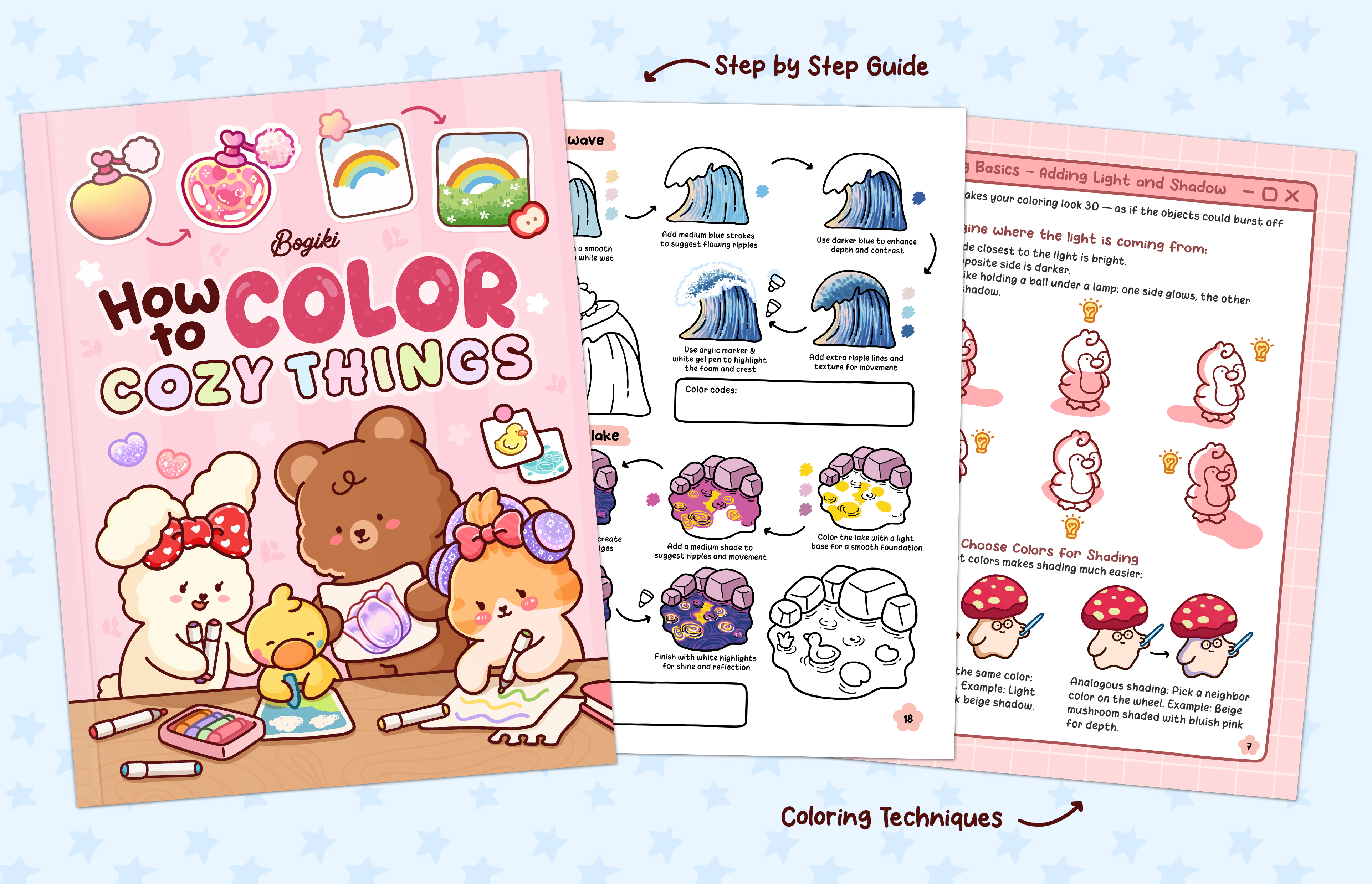
Start your coloring journey with the Bold & Easy Coloring Book, designed for pure relaxation and instant creativity. With its clean outlines and large, open shapes, this book makes coloring feel effortless and enjoyable, no matter your experience level. Each page is simple yet satisfying, helping you unwind, refocus, and enjoy the calming rhythm of color as it fills the page.
This book is an ideal choice for busy people who don’t have much time during the day – you can spend just 30 minutes coloring to relax and recharge.
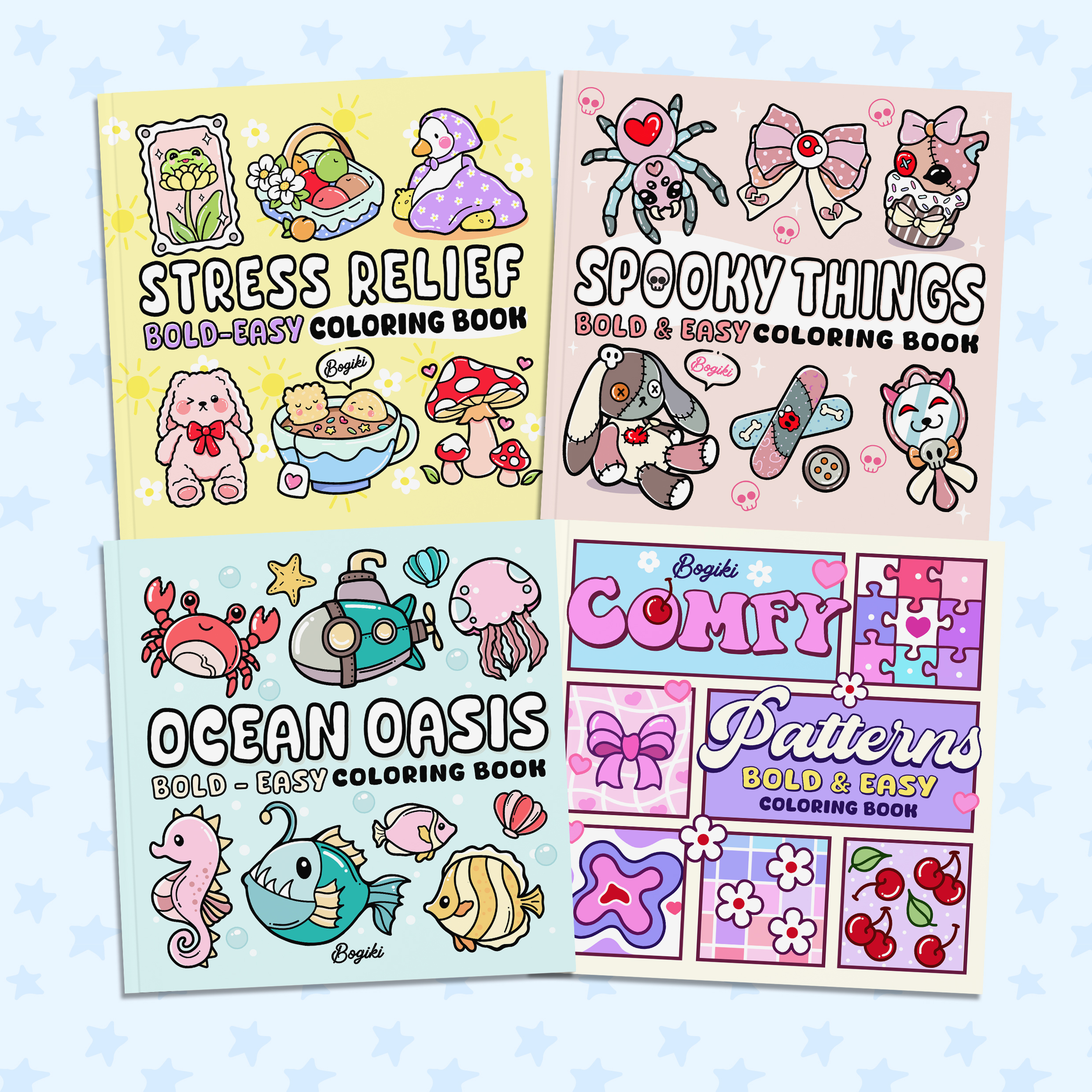
The Cute & Comfy Coloring Book welcomes you into a cozy world filled with tender scenes and heartwarming characters. Each illustration radiates a sense of warmth and positivity, reminding you of life’s simple joys. With 40 hand-drawn pages, this coloring book is an ideal choice for anyone who loves soft aesthetics, gentle details, and the comforting charm of everyday moments. Let every stroke of color bring you a little smile and a lot of calm.
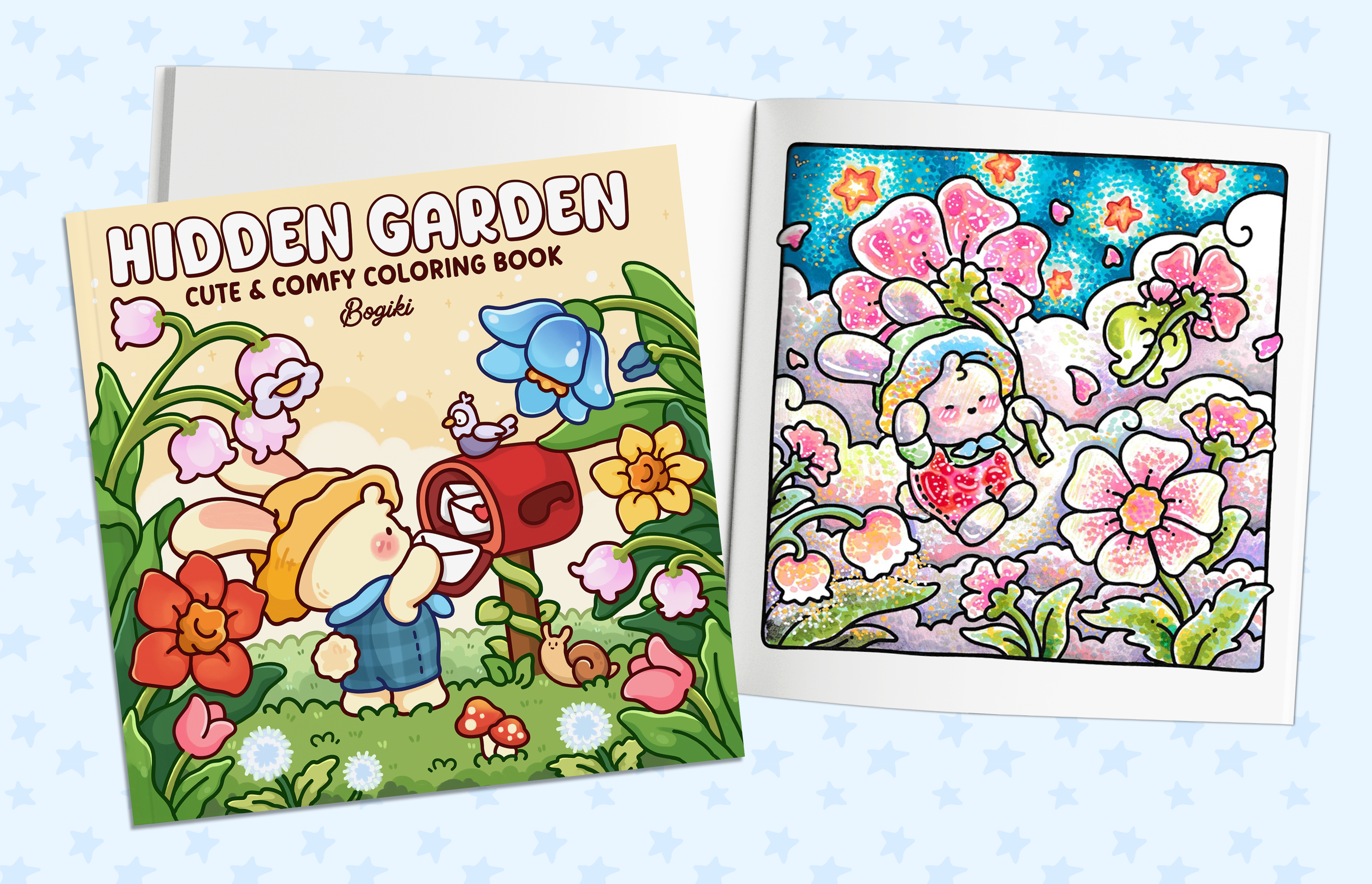
We offer a selection of free coloring pages from our books, so you can try them out and enjoy a taste of the coloring experience before choosing a full book.
Ready to start coloring right away?
👉Visit Bogiki’s Free Coloring Pages to learn how you can access a variety of beautifully designed sheets made especially for beginners. The page guides you step-by-step on how to download free printable pages directly from each coloring book category.
Once there, you can choose your favorite themes, follow the download instructions, and enjoy coloring comfortably at home — anytime, anywhere.
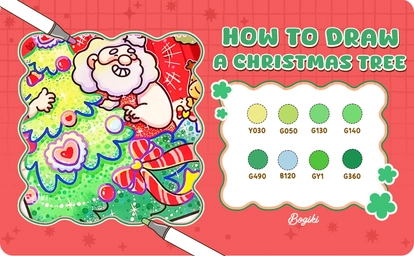
When winter begins to sparkle and colors fade into soft white, a Christmas tree becomes the perfect canvas to bring warmth and light back to your art. In this How to Draw a Christmas Tree tutorial, you’ll explore coloring techniques that make your artwork glow, from blending rich greens and gentle lights to adding subtle highlights that capture the holiday magic..
Start at the top with mossy green (Y030). Blend in spring green (G050) and deeper tones (G130, G140) as you move downward.
This gradual layering adds depth naturally, creating a Christmas tree that feels alive and inviting. Paying attention to subtle shifts in color not only adds a more realistic touch but also helps beginners explore the core techniques of drawing a Christmas tree while keeping the process fun and stress-free. Each layer of green builds your tree’s foundation and sets the tone for the details to come.
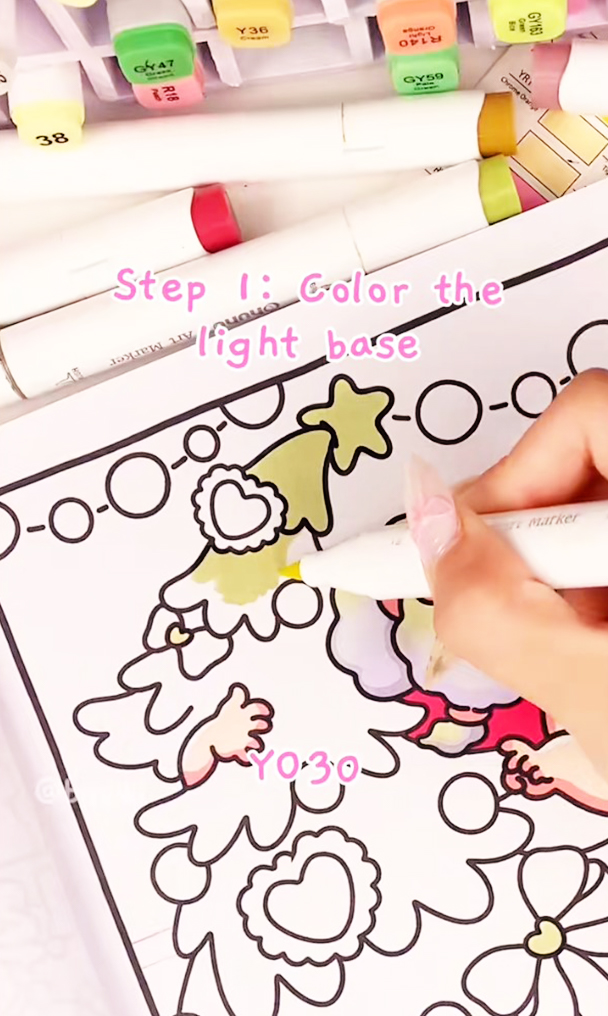
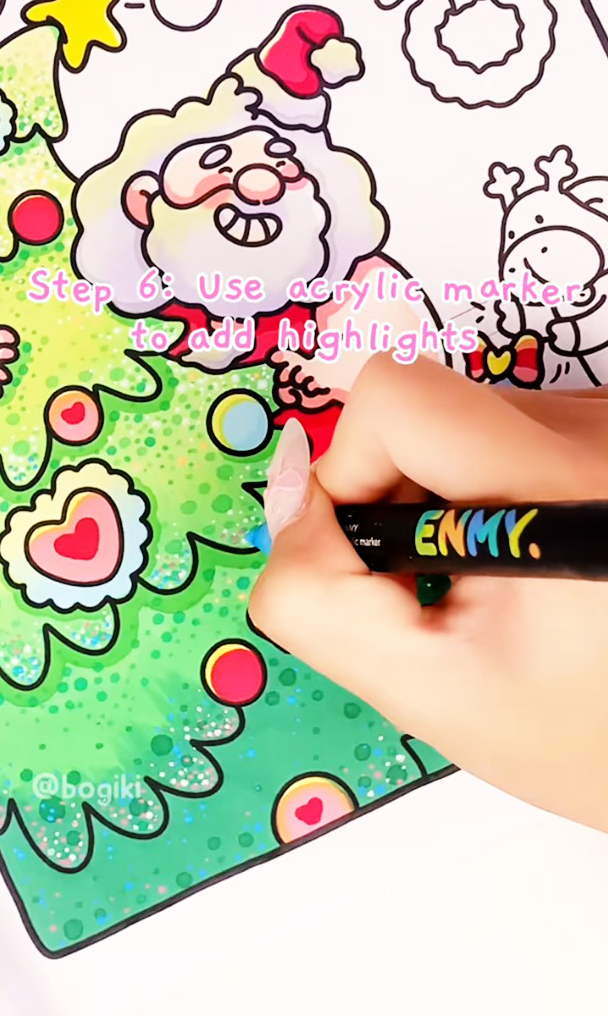
Next, add richer greens (G490) to the lower branches and base of the tree. This subtle contrast between lighter tops and darker bottoms gives your tree stability while maintaining a delicate, soft charm.
These deeper shades also suggest the natural shadows found on a tree resting in a quiet winter garden. Learning how to draw a step-by-step Christmas tree includes observing and replicating these small tonal changes, which add depth and make the drawing feel three-dimensional without feeling heavy or overworked.
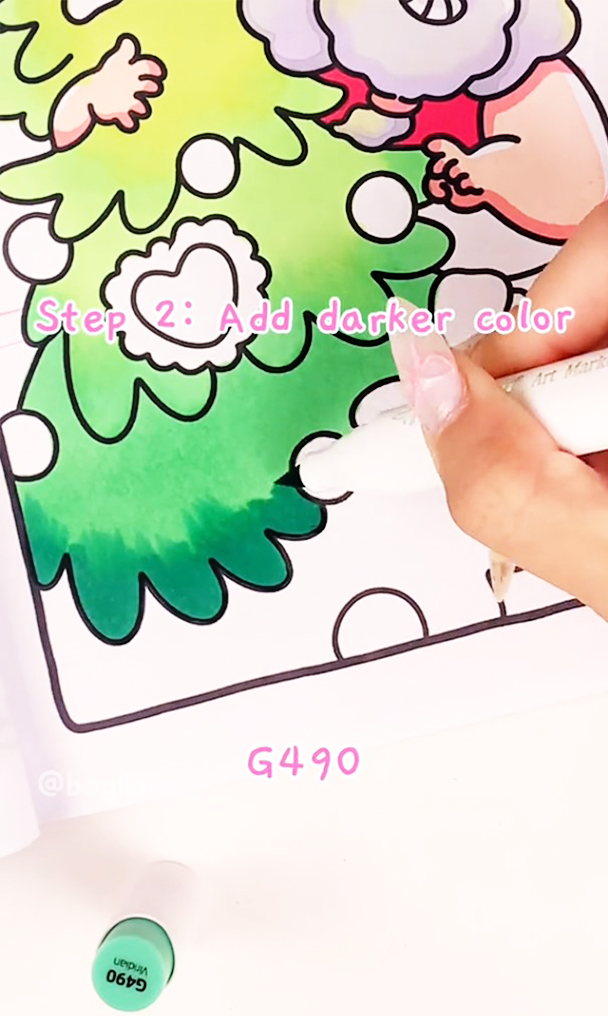
Use slightly darker shades (G140) to gently shadow the lower branches while keeping the upper layers lighter. These soft shadows bring dimension and volume, helping the tree feel lush and natural.
You can vary the pressure of your strokes to create subtle transitions, making the foliage appear soft and layered. Shadows aren’t just visual; they help guide the viewer’s eye across the tree, highlighting areas where light might naturally hit and creating a gentle, festive glow.
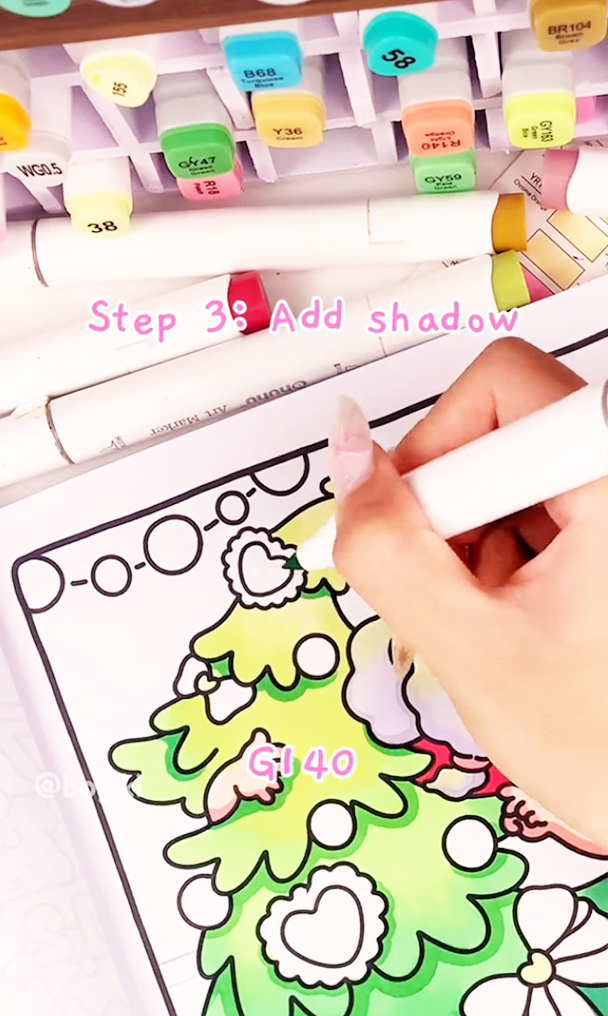
Now it’s time to add a playful texture. Scatter small green dots in different shades across your branches: (G140) near the edges, (G490) on lower leaves, and (G130) at the top.
These dots resemble morning dew or tiny snowflakes resting on branches. By varying size and placement, you add visual interest and a sense of movement to your tree. This technique is particularly helpful for beginners learning how to draw a cute Christmas tree, allowing them to create depth without complicated shading techniques.
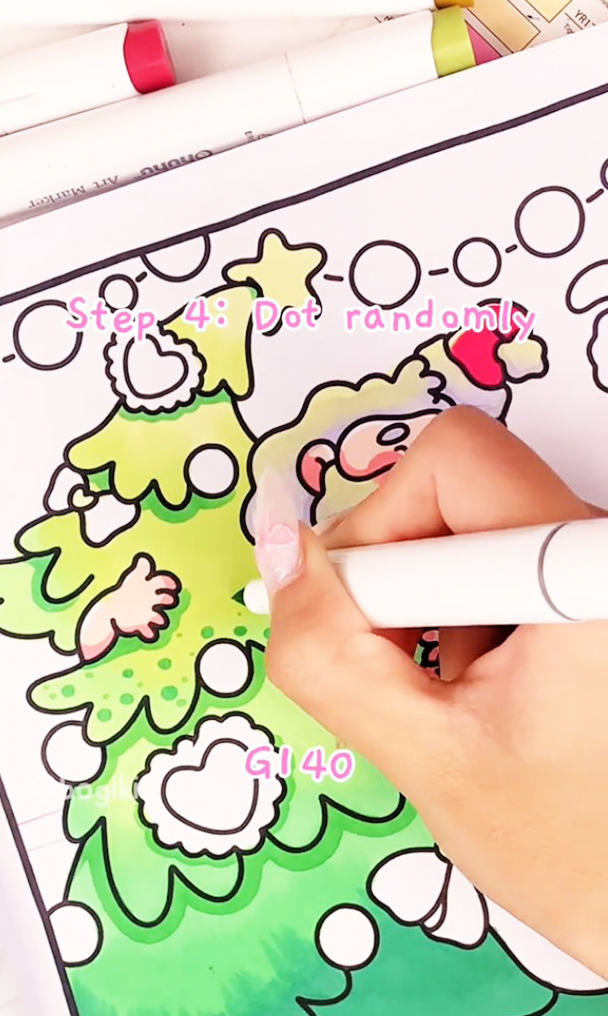

Enhance selected areas with darker green touches (G360). This step adds subtle contrast, emphasizing the natural variation in the tree’s foliage.
Adding these accents is a key part of creating a tree that looks rich and full. It also trains your eye to notice the little details that make a Christmas tree special, from the uneven growth of branches to tiny clusters of leaves that catch light differently. These finishing touches are what give your tree personality and charm.
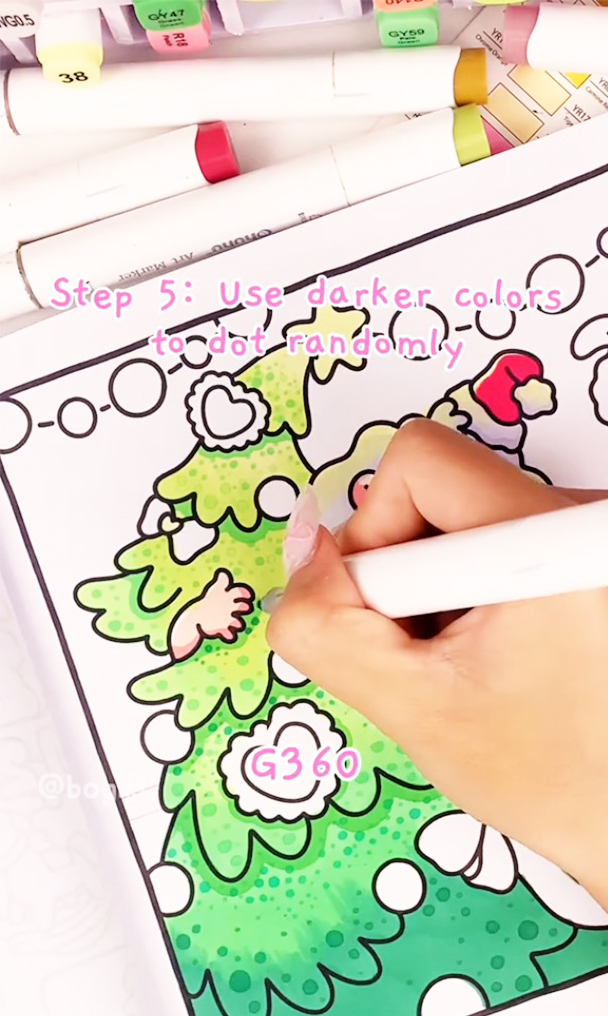
Now comes the fun part: sprinkling sparkling highlights across the branches. Use acrylic markers or gel pens in white, pink, soft orange, and green to add tiny shining dots.
Imagine each speck as a playful dusting of snow or a twinkling fairy light. These sparkles bring life to your tree and elevate it from a simple drawing into a festive centerpiece. Learning how to draw a Christmas tree isn’t just about the structure; it’s also about capturing that whimsical holiday feeling.
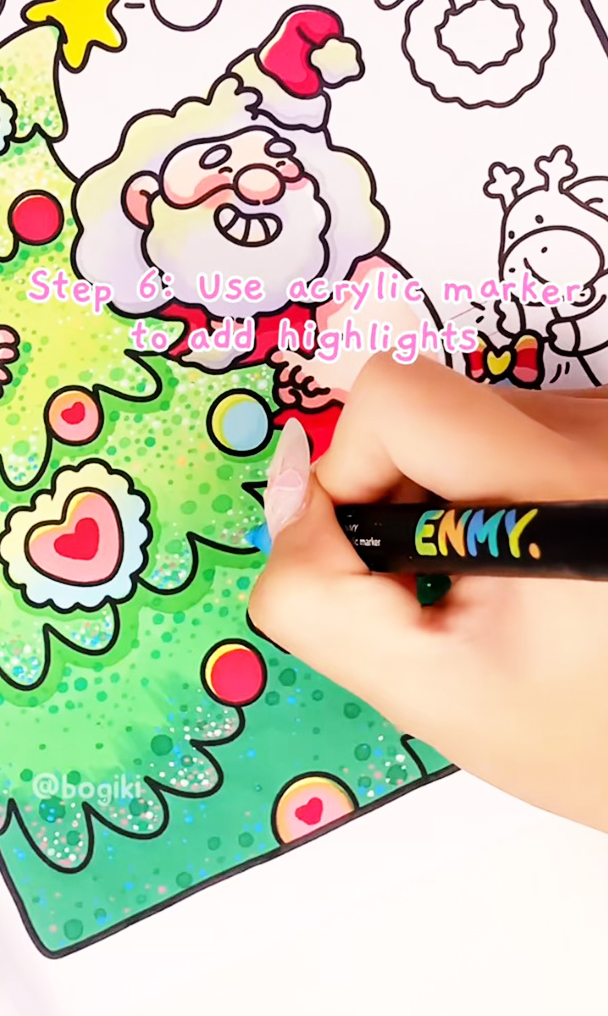
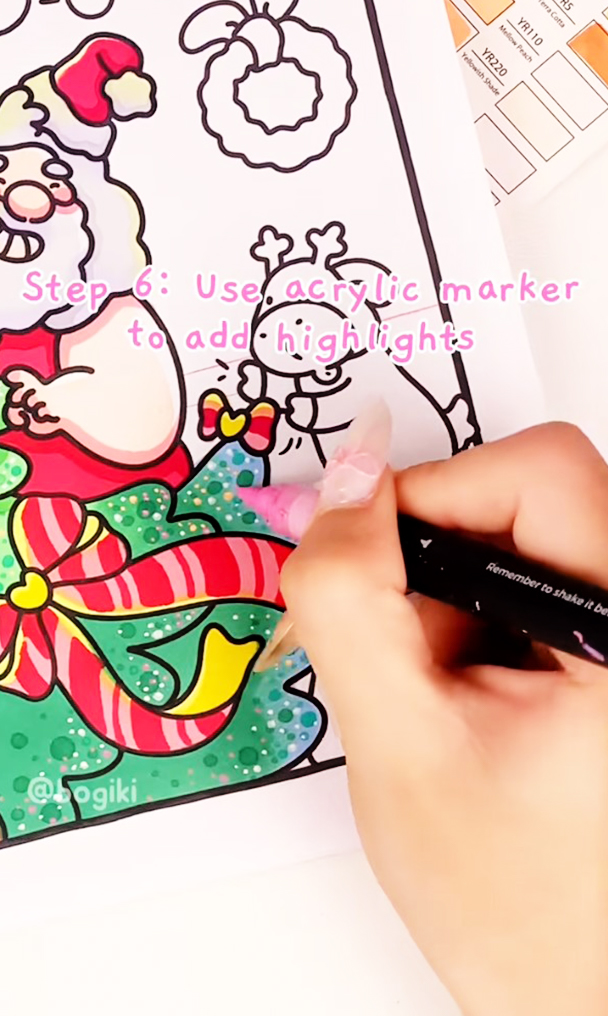
These final touches give your tree a soft, luminous glow, making it feel gently illuminated from within.
Focus on areas where you naturally imagine light reflecting. This step enhances the tree’s three-dimensional quality and reinforces the magical, cozy feeling associated with the holiday season.
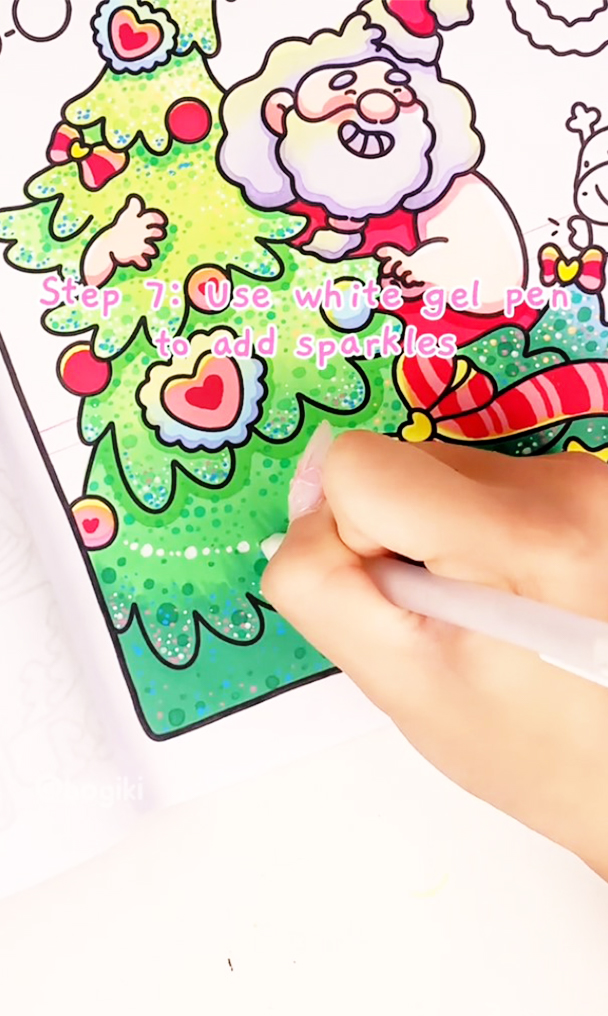
Use acrylic markers or paints to cover the initial black outlines, giving your tree a softer and more natural appearance. Skillfully blend multiple shades of green, from light to dark, to create a vibrant gradient effect, highlighting each layer of foliage and adding depth.
This step not only makes your tree visually appealing but also helps all the details blend seamlessly, avoiding the rigid look of outlines. It’s a clever technique that turns a basic drawing into a rich, lively Christmas tree, perfect for anyone learning how to draw a Christmas tree easily.
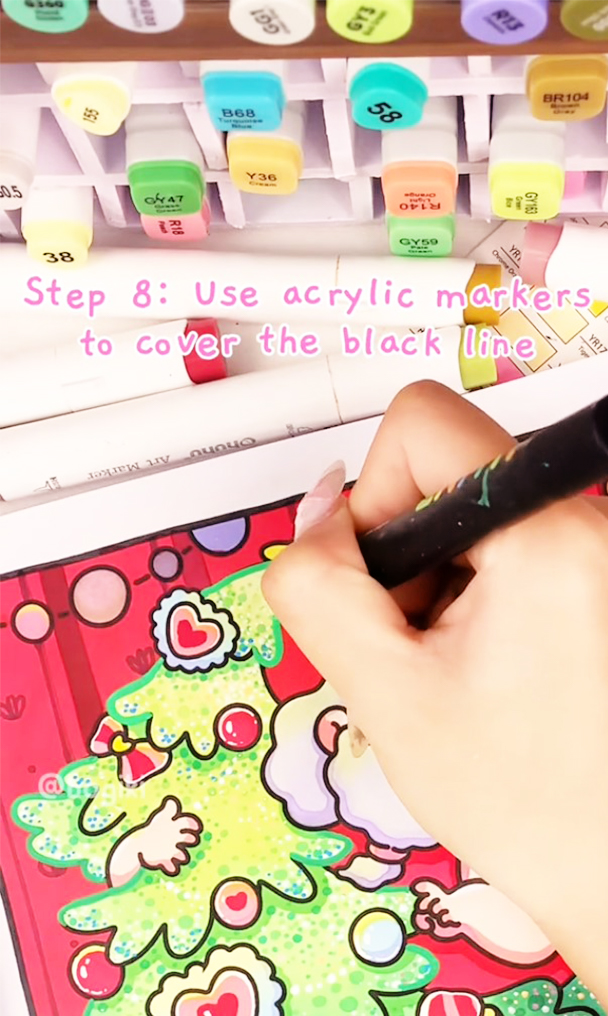
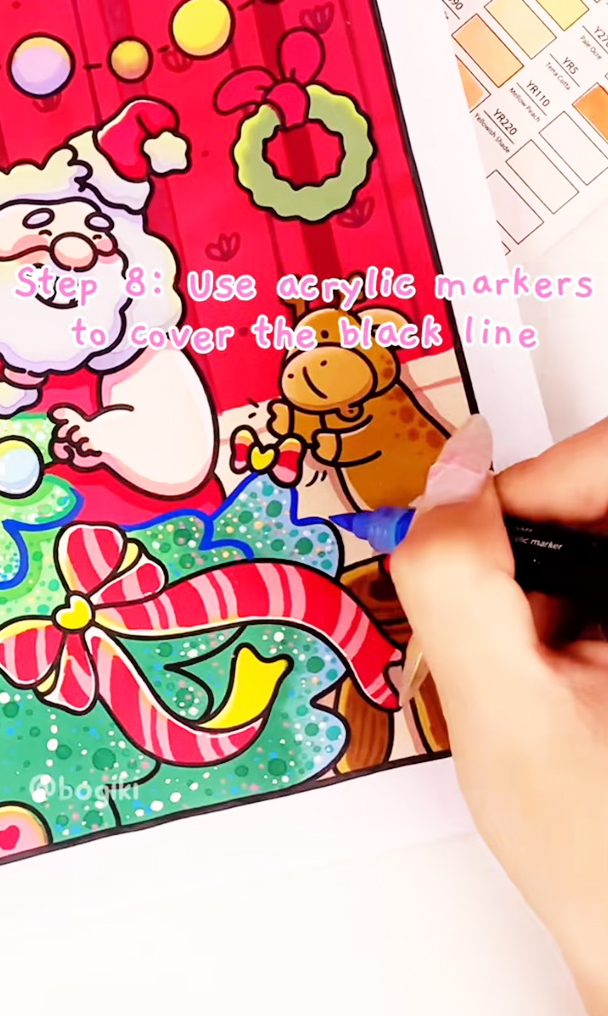
Admire your work. Your Christmas tree is no longer just a drawing; it’s a celebration of creativity, imagination, and the joy of the season.
Notice how each branch, shadow, and sparkle comes together to tell a story. You’ve transformed a blank page into a magical moment, filled with warmth and personal charm. Add a few whimsical touches if you like extra sparkles or playful snow dust, and let your tree tell its own holiday tale

The Christmas tree you just colored is only a small part of Bogiki’s magical holiday world. If you love the joy and sparkle of the season, let your creativity wander through cheerful Santas, cozy winter cottages, and sparkling ornaments.
👉 Bogiki’s Fuzzy Holiday Coloring Book is your gateway to this colorful holiday wonderland. Begin your creative journey by exploring delightful illustrations and bringing each festive scene to life.
👉 Watch the How to Draw a Christmas Tree video for step-by-step guidance and see your holiday artwork truly shine.
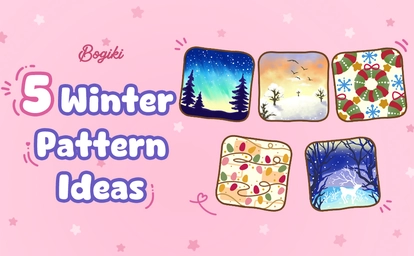
Winter isn’t just a season of cold and gray skies; it’s a canvas of soft light, cozy moments, and magical patterns waiting to come alive in your coloring. Whether you’re a beginner or a seasoned artist, exploring winter patterns can turn simple strokes into heartwarming works of art.
In this guide, we’ll explore 5 cozy winter pattern coloring ideas from Bogiki. Each pattern comes with step-by-step guidance to make your drawing shine with winter’s gentle beauty.
Start with the mesmerizing Northern Glow winter night, where mystical colors streak across the sky and snow-dusted pines glimmer under twinkling stars. This scene works beautifully for landscape illustrations or window views, bringing a calm, magical glow to your artwork. It’s a straightforward winter pattern that’s perfect for both beginners and experienced artists alike.

Capture the soft golden light of a winter sunrise spilling over snowy mountains, infusing warmth and serenity into your scene. This pattern is especially charming for journal pages or small wall illustrations, where the gentle morning glow can breathe life into your winter landscape. Golden Dawn emphasizes early-morning light, mountain shading, and depth, helping you balance highlights and shadows for a vibrant, three-dimensional effect.
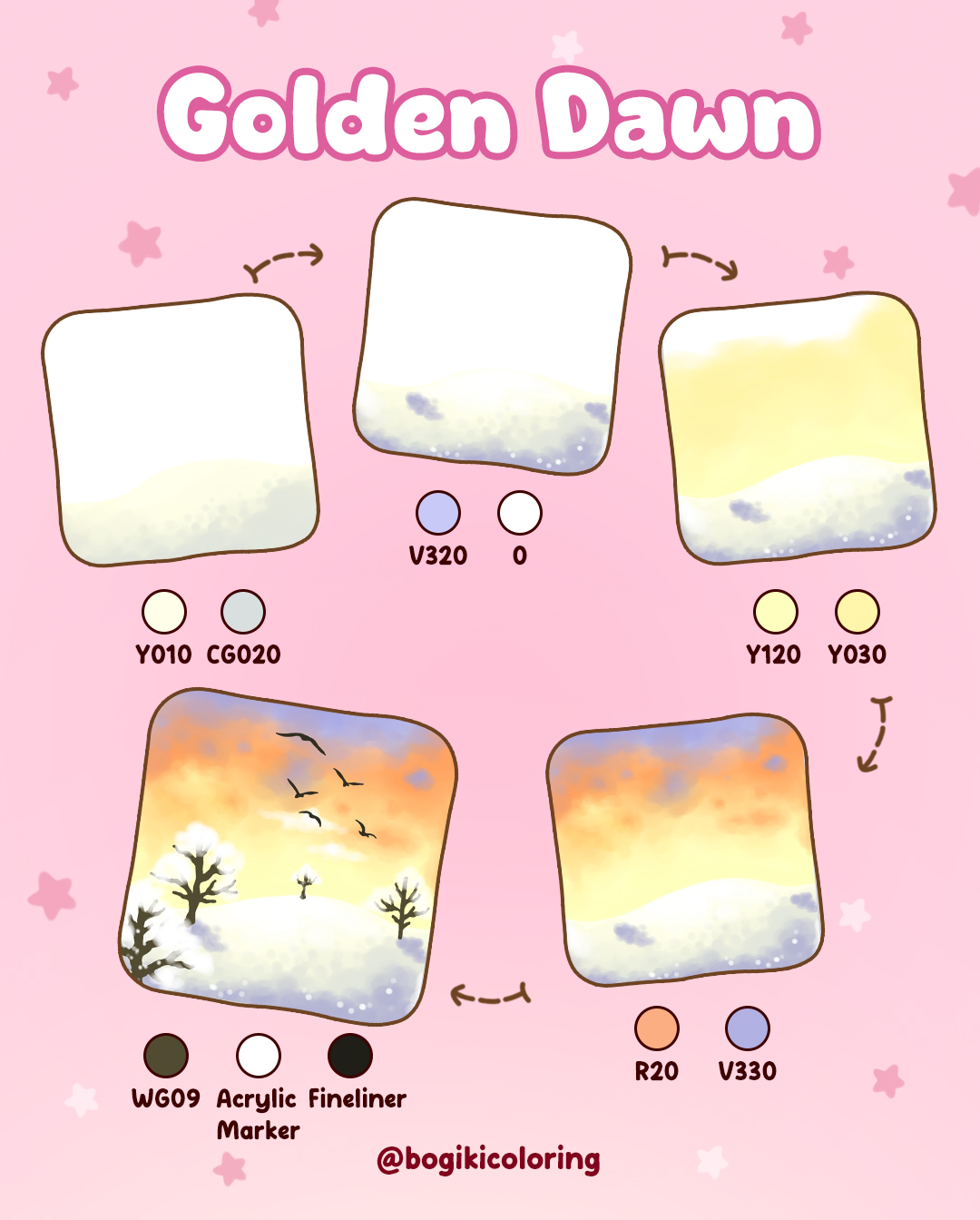
Bring your festive winter artwork to life with cute winter patterns like Festive Wreaths, filled with vibrant colors and sparkling lights. This pattern emphasizes cheerful, warm details, helping you practice color blending, decorative motifs, and highlight accents.
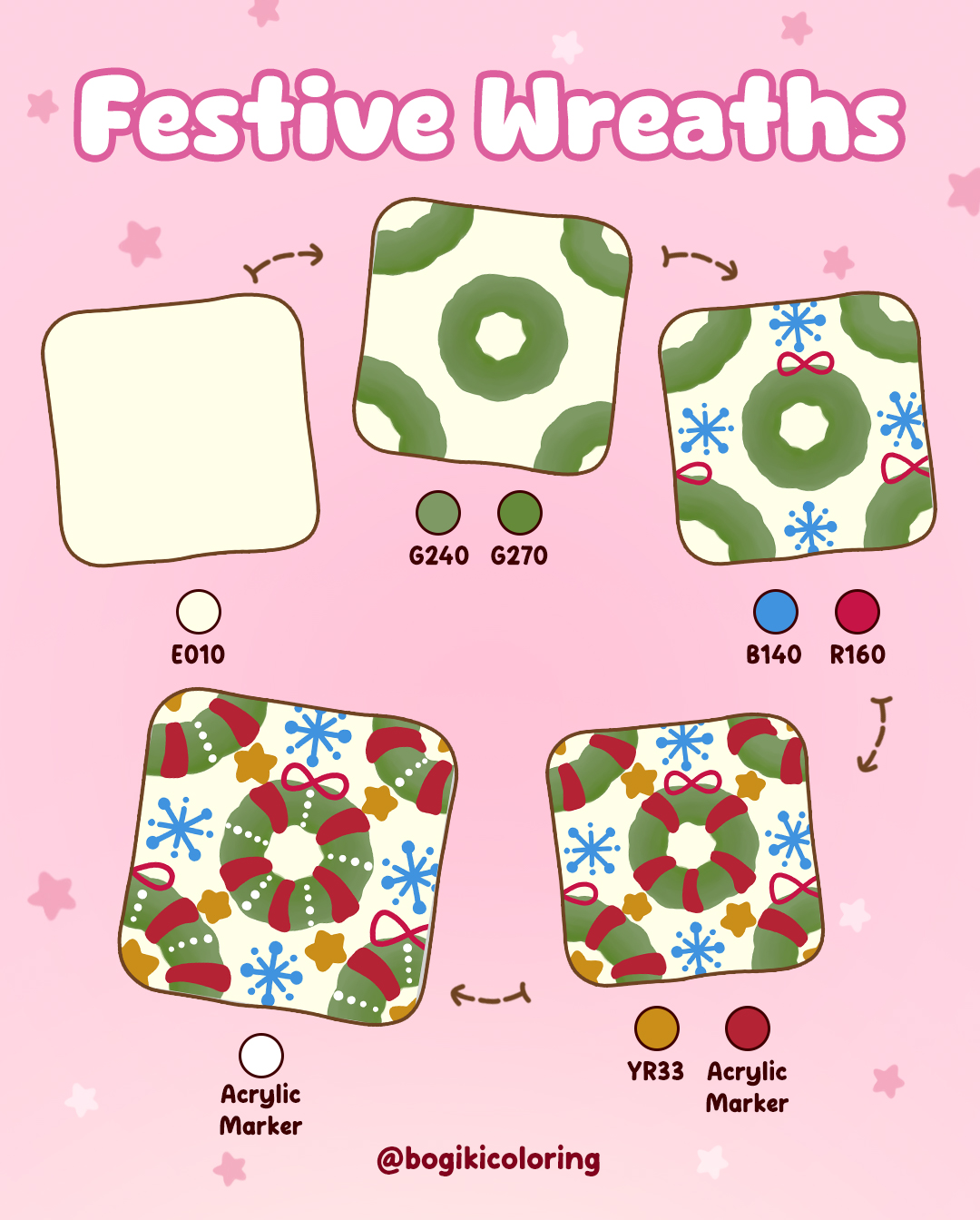
Turn your winter scene into a warm, inviting space with the soft glow of Cozy Lights. Perfect for planner pages or indoor illustrations, these gently glowing bulbs spread a sense of comfort and joy across the page. This technique focuses on smooth color blending, delicate details, and the charm of multi-colored lights, creating a lively yet cozy atmosphere.

Explore a quiet, mystical winter forest under the moonlight with the Soft Stroke technique. This design works beautifully as a storybook background or journal page, where the moonlight and gentle shadows create a dreamy, serene setting. Layered base colors with subtle highlights add depth and space, bringing the forest to life while preserving its tranquil, magical atmosphere.
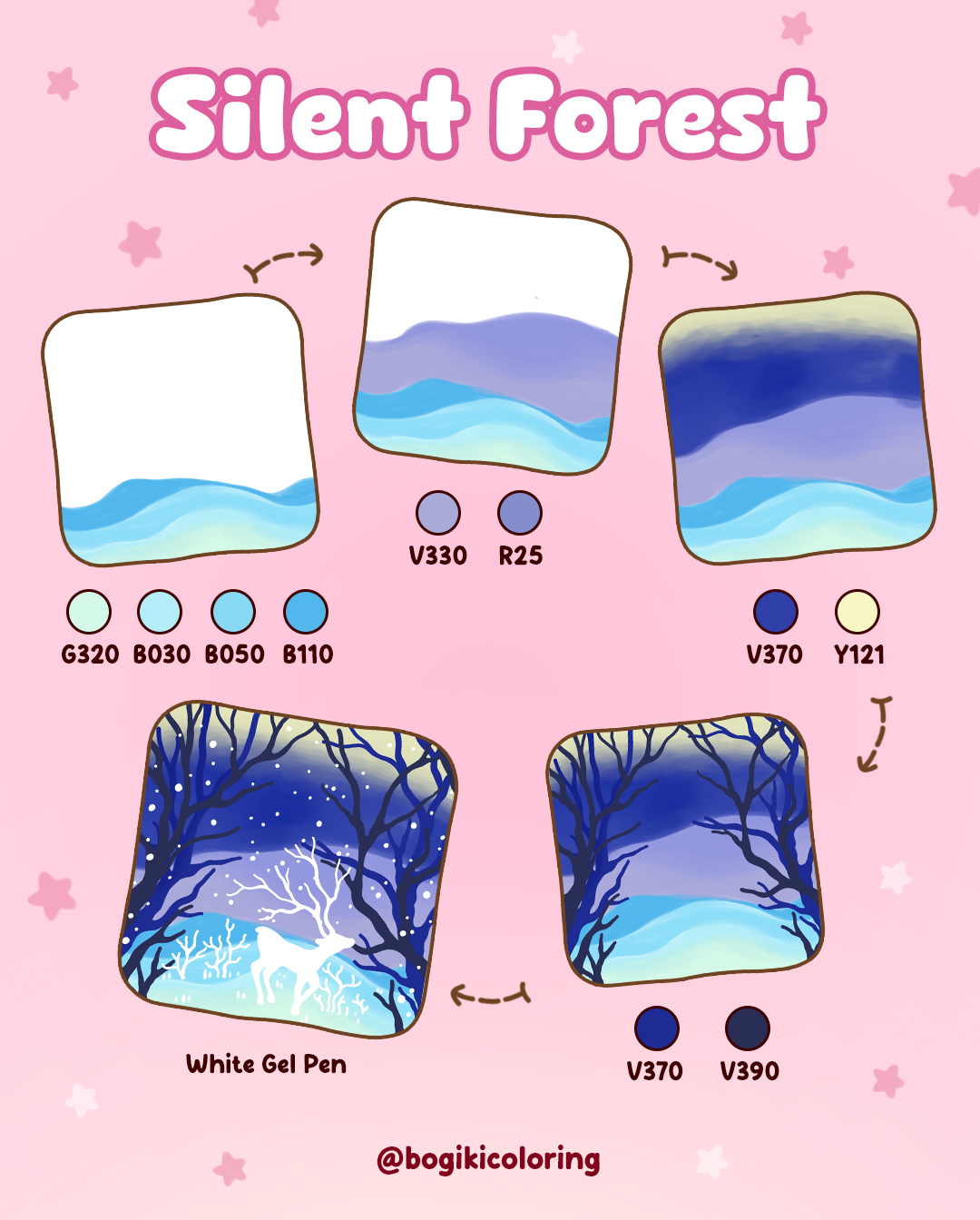
The five winter pattern ideas you’ve just discovered are just the beginning of an enchanting artistic journey. In Fuzzy Holiday, serene beauty and hidden winter scenes are waiting to be revealed. Delicate designs guide your mind into a state of relaxation, bringing peace and rekindling joy in life’s simplest moments. Each charming pattern and delightful scene tells a little story, gently inviting your imagination and creativity, transforming cold winter days into warm, inspiring experiences.
Pick up your coloring tools and let winter come alive through your colors with Bogiki!
👉 Get your copy of "Fuzzy Holiday" today and start your journey to explore the cozy beauty of winter!
Treat your inbox to a lovely surprise! Sign up now for exclusive content and special gifts

1311 Park St Alameda, CA 94501
+1 (945) 215- 8881
studio@bogiki.com
*Currently, we are unable to handle your call/voicemail/phone message. Please go to our Contact Form and leave an email.












